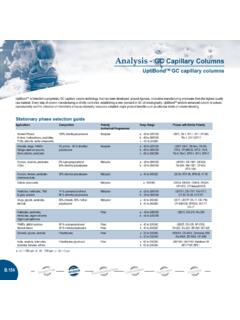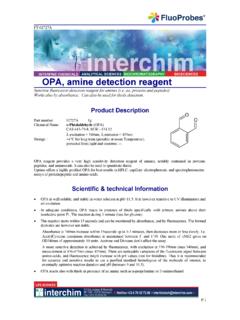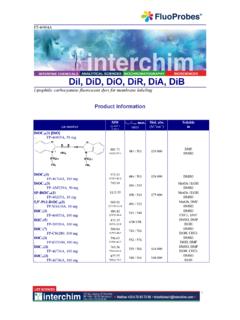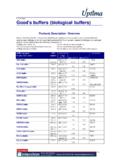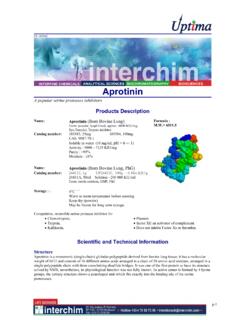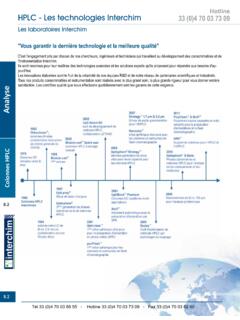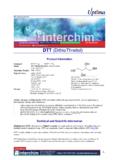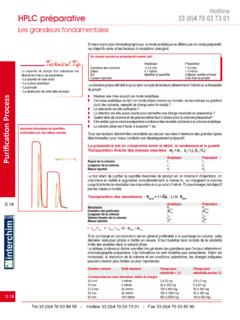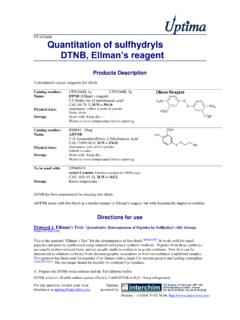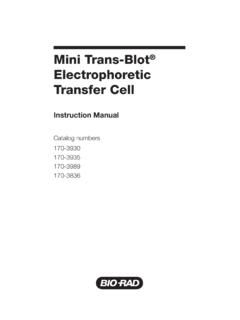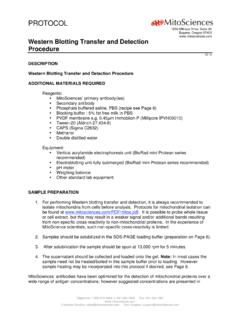Transcription of NT-47255g Protein Electrophoresis in Agarose Gels
1 NT-47255gProtein Electrophoresis in Agarose Gels+IntroductionProtein Electrophoresis in Agarose gels is an alternative approach to using polyacrylamide gels and provides several benefits. Gels can be run using a vertical system or a horizontal system and unlike polyacrylamide gels, Agarose gels can be used effectively to separate proteins larger than 600 000 : Separate high-molecular-weight proteins (>600 000 kDa) Easy to prepare and handle Efficient recovery of proteins Excised proteins can be used to immunize animals directly for antibody production Non-toxicRecommended agaroses for Protein electrophoresisThe table below is a list of Agaroses that are recommended for Protein Electrophoresis .
2 For performing routine separations, we recommend a standard melting temperature Agarose such as SFRlow melting#.When proteins are to be recovered for further analysis, use a low melting temperature Size Range Agarose Concentration20 200 kDaStandard Agarose #31272L5%150 300 kDaSFR Agarose 3%300 600 kDaSFR Agarose 2%600 1 ,000 kDaSFR Agarose (Low Melting Agarose ) 000 5 000 kDaSFR Agarose (Low Melting Agarose ) for Protein Separation in AgaroseThe buffer systems used for Agarose Electrophoresis are similar to those used for polyacrylamide Electrophoresis . When performing horizontal Electrophoresis , we have found that a Tris-borate gel and running buffer provide greater resolution than using the standard Laemmli buffer and horizontal gel:1X STACK BUFFER, pH g/l for 1X STACK BUFFER125 mM Tris-HCl g Tris-HCl in 1 liter distilled waterNOTE.
3 Horizontal gels do not require the use of a stack RESOLVING BUFFER, pH g/l for 1X RESOLVING BUFFER500 mM Tris base g Tris base160 mM Boric acid g Boric acid1 M Urea g UreaAdjust volume to 1 liter with distilled water1X RUNNING BUFFER, pH amount for 1X RUNNING BUFFER90 mM Tris base g Tris base90 mM Boric acid g Boric SDS 10 ml of 10% SDSA djust volume to 1 liter with distilled waterContact your local distributorUptima, powered buffer: Gels can be made with standard Laemmli buffer. To avoid excess foaming during Agarose dissolution; only add SDS to the cathodalbuffer and not to the gel buffer. The SDS in the cathodal buffer will migrate faster than the proteins during Electrophoresis , maintaining Protein denaturation.
4 To prevent buffer depletion in vertical systems, use 10X Laemmli buffer without SDS in the anodal for buffer preparation: Add SDS to the cathodal buffer only. Do not add SDS to the gel prior to dissolution. If other buffer systems are used, the pH should be between pH 5-9. Denaturants such as urea and formamide should only be added at lowconcentrations (4 M-6 M Urea). For buffers more alkaline than pH 9, dissolve and cast the Agarose in distilled water, allow to gel. Soak horizontal gels in the alkaline gel buffer for 30 minutes prior to Electrophoresis . For vertical gel systems, prerun the gel to equilibrate the gel with the alkaline Agarose Gels for Protein SeparationThe procedures for dissolving and casting Agarose gels for Protein separation are the same as the procedures used for nucleic acid for casting horizontal Agarose gels: Use of a stacking gel is not necessary for horizontal submarine Electrophoresis .
5 The resolving gel buffer and running buffer should be the the Agarose in running buffer without denaturing Electrophoresis , add SDS to the sample buffer and the running buffer. Let the gel set for 20-30 minutes at room temperature. For Agarose , chill the gel at 4 C for 20-30 minutes before removing comb. If gels are to be dried, cast the gels onto GelBond for casting vertical Agarose gels:Stacking gel for vertical gels: Prepare a 1% low metling temperature Agarose gel in stacking gel buffer. For proteins >100 kDa, the use of a stacking gel may be omitted. It will not enhance band resolution. After the stacking gel is set, place cassette at 4 C for 30 minutes prior to removing the gel for vertical gels: Dissolve the Agarose in running buffer without SDS.
6 Refer to Vertical Gel Casting Instructions. Allow resolving gel to set approximately 3 minutes at room temperature then cast the stacking facilitate comb removal from a vertical gel: The teeth of the comb can be tapered so the width at the bottom is slightly smaller than at the top. A slight rounding of the edges is all that is needed so that the end is U-shaped. Tapering the teeth in this way will not affect the pattern of the Protein bands. Flood the comb area with running buffer prior to removing the comb. If clamps are used, remove the clamps at the top of the gel cassette and gently loosen the comb by moving it forward and back before your local distributorUptima, powered and Loading of Protein SamplesSample preparation and amount of Protein that can be loaded on Agarose gels is essentially the same as for polyacrylamide gels and is largely dependent on your application and detection : Suspend Protein samples in 2X sample buffer, 1:1 (v:v).
7 If denatured proteins are required, incubate at 95 C-100 C for 5 minutes. Load the samples into the sample wells. The minimal amount of Protein detectable by Coomassie brilliant blue stain is about g; and may vary depending on the Protein . Larger amounts of Protein can be loaded, but band thickness increases accordingly. For a cm wide well, 25 ml (50 g total Protein ) is recommended for a complex mixture, if staining with Coomassie blue, and 1 ml (10 g total Protein ) is needed for samples containing one or a few proteins. For vertical Electrophoresis , load empty wells with sample Tris-Glycine SDS sample buffer for Agarose Electrophoresis of proteins:2X concentrate:Amount to add for 10 ml:126 mM Tris-HCl, pH ml of M Tris-HCl, pH Ficoll Type 400 g Ficoll Type 4004% SDS 4 ml of 10% Bromophenol Blue ml of Bromophenol blueAdjust volume to 10 ml with distilled waterBefore use: add 1 ml -Mercaptoethanol ( ME) to 10 ml of 2X Tris-Glycine SDS sample bufferOptimal Voltage and Electrophoretic TimesTips: Avoid higher power settings as the heat generated may melt the Agarose .
8 Thick vertical gels (>1 mm) will require proportionally higher current settings to complete the Electrophoresis run within the times indicated. Electrophorese the gel until the tracking dye travels to the bottom of the resolving gel. Prestained molecular weight markers such as Coolored Protein Markers #L77151 can be used to monitor Electrophoresis . The gels can be electrophoresed longer, but care should be taken that smaller proteins do not travel off the TypeHorizontal Gel Vertical Gel Mini-VerticalGel cm x cm x .4 cm cm x cm x .1 cm 8 cm x 10 cm x .1 cmPower Setting100 volts 25 mA (constant)(approximately 80 volts at the start and 120 volts at the end)20mA(approximately 50 volts at the start and 200 volts at the end)Time3 - 4 hours 3 - hours - 2 hoursDetection of Proteins in Agarose GelsThe procedures for staining Agarose gels with Coomassie blue stain are essentially the same as they are for polyacrylamide gels with some modifications (listed below).
9 For detailed procedures on Coomassie staining refer to Detection of Proteins on Polyacrylamide Gels (see page 193), using the modifications listed below. For detailed procedures on Silver staining refer to Staining Proteins with Silver Stain (see page 218 in Isoelectric Focusing of Proteins on Agarose Gels).Contact your local distributorUptima, powered Agarose gels require more time to process than polyacrylamide gels of similar dimensions. Staining and destaining times will vary depending on the gel concentration, thickness and Protein concentration. Place container on shaker with gentle motion during staining and destaining proteins with Coomassie brilliant blue stain:COOMASSIE BLUE STAIN SOLUTION DESTAIN SOLUTION40% Methanol 20% Methanol10% Glacial Acetic Acid 5% Glacial Acetic Coomassie brilliant blue R-250 Room temperature staining: A cm x cm, 1 mm thick Agarose gel will stain in approximately 1 to 2 hours.
10 Destain for 1-4 hours with gentle shaking at room temperature: Overnight staining Use Coomassie blue R-250 with the same concentrations of methanol and acetic acid as in the stain solution. Destain approximately 4 staining: Stain gels using standard stain solutions at 50 C. A 1 mm thick gel takes approximately 1 hour to stain and 1 hour to destain. Change the destaining solution 1 time. Agarose gels become softer at 50 C - use a support to transfer between : Do not store Agarose gels in destain solution, they may become brittle and fracture. Store gels in a 5% glycerol solution or Drying and PreservationAgaroses gels can be dried overnight at room temperature, dried in a forced hot-air oven or dried using a standard vacuum gel dryer.
